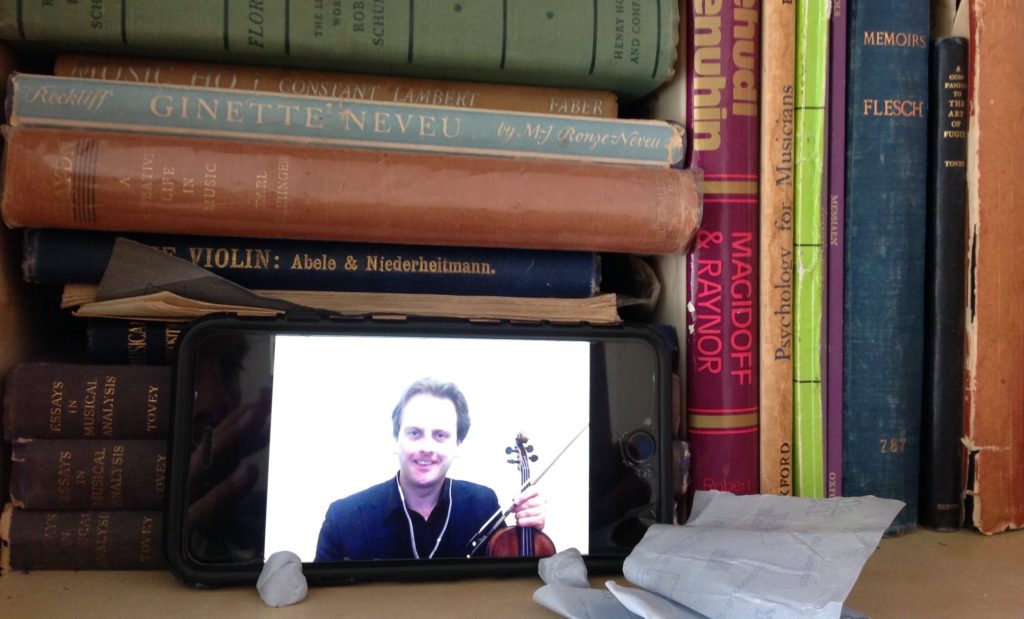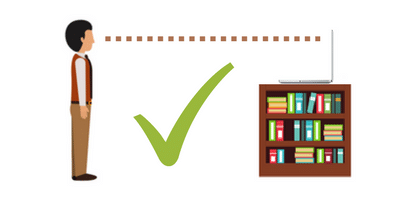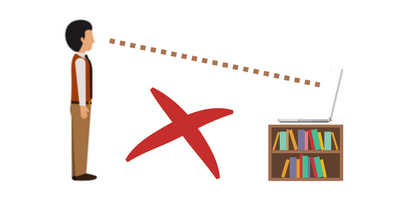Here are 10 really useful tips for getting the best results when recording your part for a virtual violin ensemble or orchestra...
Click the play button below to hear this feature, or download the MP3 to listen offline!
1) Record horizontally not vertically.
If you record vertically when you're holding your violin in playing position, then either the instrument will be cut off the screen because you're too close to the camera, or it won't be possible to crop your video to the right size because you'll be too far away, and the resolution won't be high enough.
So please, set up your device *horizontally* not vertically before you record!
2) Choose a Good Camera Angle.
A lot of people put their phone or tablet on a piece of furniture, and have it pointing up at them whilst they play. The problem with this is that all the viewer sees behind you is your ceiling!
So make sure that your camera is pointing directly at you. If you're recording with a computer, then the screen should be exactly vertical.
If you're using your phone to record but you don't have a tripod, then balance it so that it's almost vertical, or use something sticky to hold it in place whilst you record.

3) Place Your Camera at Eye Height
To get the right camera angle, you're also going to need your camera to be at eye height. If you're recording at home, try to find a shelf or a bookcase that's nearly as tall as you, and set up your device there.

If you can't find a piece of furniture that's high enough, it might be better to record sitting down instead. Set up your phone or laptop on a table, and if you don't have a tripod, use some books or other heavy objects to balance your phone in place.

4) Light In Front, Not Behind
When it comes to basic lighting, there's only one thing you need to remember ... the strongest light should be IN FRONT of you ... not behind you!
Just make sure you're not filming yourself in front of an outside window or a bright light, and you should be OK.
If the sun is shining, then you should be facing the sunlight - don't record with the sun behind you!
5) Check The Dress Code
If there's a dress code for your virtual orchestra or ensemble, then make sure that you check it before you record! That's one thing that can't be fixed in the edit!
6) Check Your Background
Also check the background of your visual image before you hit the record button. A simple or plain background is fine, but if you're recording at home, it's always a good idea to check that laundry, unwashed dishes, the remains of yesterday's cake, or your child's toy monkeys aren't photobombing you without your permission...! Trust me, I know this to be true 😉
7) Use Earphones
You have to use earphones if you're recording a virtual ensemble part. This is because you'll always have to play at an exact tempo, so that the different parts can be stitched together by the editor.
You need to wear earphones so that you can listen to a reference track or a metronome beat whilst you play, without the sound being picked up by the microphone that's recording you!
This is exactly how string musicians work in a studio recording session. On the right ear, each player wears a single-ear headphone, which is like a headset *without* a microphone.
The metronome beat, known as the 'click track', is pumped through the right earpiece. But the left ear remains clear, so you can keep listening to what you're playing, without distraction.
You might like to try this with your own earphones, to find out what works best for you.
Always check the BPM, or 'beats per minute', that's been agreed for the piece you're recording. This tells you the tempo you'll need to play at. Set your metronome to this tempo.
8) Hide Your Earphones
Wired earphones can look messy on camera, so *hide* them if you can. Try running the cable behind your shoulder and down your back, or inside your clothing.
9) Angle Your Violin Towards The Camera
Your performance may be pre-recorded, but it's still a performance. So the *angle* of the violin is important - make sure that you're facing the camera just as you'd face an audience from a concert stage ... rotate your body very slightly to your left, so that your violin is facing directly towards the camera.
Don't rotate too far to your right, otherwise all the viewers will see is the scroll of your violin.
10) 'Perform' the Beginnings and Endings Too!
As with a live performance, the beginnings and endings of your recording are really important.
Be in playing position, ready to start, at least a couple of beats before you play the first note. And at the end, hold your position for a moment or two, before you bring your violin down.
This will give your editor time to fade the visuals in or out, and make sure that your performance matches up visually with the rest of the group. Don't forget to smile!
P.S. ... Name Your Files!
Here's a bonus 11th tip for you that will take you no more than a few seconds, but will save your editor a LOT of time! ... make sure to name your video files correctly!
We recommend putting your first name then surname, then the name of your ensemble or project, then the name of the piece, like this:
Simon Jones - Course A July 2030 - Twinkle Twinkle Little Star.mp4
It's a small thing to do, but it makes it *much* easier to organise at the production end! And most importantly, it reduces the chance of your recording getting lost, or not making it into the final cut of the video.
These tips might individually seem like small things. But together, they make a massive difference to the level of production quality that your ensemble can achieve.
Try to remember them, and lift your video to the next level. Good luck with your recording!

Listening is one of the most important skills you can have. How well you listen has a major impact on your effectiveness at work, your relationships and your musical practice.
Listening enables you to learn, to obtain information, to understand and to enjoy, yet it can often feel like an abstract ability. Research suggests that most people remember only 25 to 50 percent of what they hear, meaning that whether you’re talking to a friend, listening to your violin teacher or listening to your violin practice, you’re paying attention to at most, half of what’s going on.
By becoming a better listener, paying attention to how you listen and what you are listening for, violin practice will improve, but good listening and its application in violin practice requires a high level of self-awareness, attention, positive attitude, flow concentration and critical thinking skills.
Listening in violin playing comes in many different guises:
First, prepare yourself to listen. Put other things out of your mind. If you notice you are thinking about what you’re going to have for dinner, allow the mind to re-focus on the music you are about to play, the sound you want to make and the shape of the musical phrase you would like to express. It is very easy to allow the brain to drift into autopilot.
Warm up by playing some long notes and slow scales. Really engage with the sound you are producing. Try to do so non-judgementally, just enjoying the variations of vibration and tone. As your body warms up, give yourself some images of colour, texture or objects, for example, a smooth piece of dark blue velvet. Visualise the feeling and the colour, and then play some notes with the same feeling. Really listen to your tone and the feelings you produce from the notes.
Practice focussed concentration. Break your violin practice into short bursts so you can really listen. The mental state in which you are fully immersed in what you are doing, known as flow or being in the zone, represents the deepest levels of performing and learning. In flow, the emotions are positive, energised and aligned with the task in hand. This level of positive focus is most likely to occur when you are practising with purpose; with a clear set of goals and progress, giving direction and structure to the practice, and with clear feedback; so having actually really listened to what you’ve just played.
It is important to find a balance between the perceived challenges of the music or technique you are practising, and your level of skill as you perceive it: You must feel confident in your ability to achieve what you want.
Broken down, this level of concentration can be achieved when you know:
If you are bored or anxious, it is very difficult to concentrate properly, and to listen to what you are really playing without negative preconceptions. Use visualisation, listen in your mind to what you want to do, listen to the results and enjoy the process. This is where your critical thinking skills will come in. Use the information gathered from listening fully to what you are doing to evaluate what you are doing and how you might develop it.
Full concentration, really listening to what you are doing, is more likely to produce the information and results you want than simply hearing what you’re playing.
Try breaking down what you hear into separate parts so you can listen more closely. Work on the rhythm, intonation, tone, phrasing and other musical ideas individually, and then start to put everything back together. Sometimes when you concentrate on the rhythm, the tuning will go funny, for example. Don’t worry about this; your brain is focussed on integrating your understanding of the rhythm. You can go back to the intonation later.
Allow your ears to listen to the sound in the whole room, not just to the sound coming from your violin. Imagine you have one ear at each side of the room. Sometimes it can be interesting to put an earplug in your left ear to hear the sound that is going into the space rather than the noise under your earhole!
Read the article about visualisation skills for more ideas and practice techniques.
You can use the ViolinSchool Auralia ear training software (included free with your ViolinSchool membership) to practice your listening skills and deepen your understanding of the music you are learning. Most music has three main ideas to notice: new melodies, repetition and variation. You can also look for colour, balance and texture, key (major or minor), rhythms and accompaniment. The more you understand about how your piece is put together, the easier it is to feel confident in how you want it to sound.
Listening to someone you admire playing the piece you are learning is one of the best ways to motivate yourself and understand the music. You can develop a mental map of the characters, colours and energies that make up your piece.
Listen to the piece as a whole and in small sections. It can be fun to listen to a phrase and then try to recreate the sounds and shapes you heard on the recording. Many beginner violin books and graded exam books now come with CDs. For children learning the Suzuki method, listening is one of the first skills learned. Suzuki encouraged his young students to listen to recordings of great violinists, and his method is based on the mother tongue ideal of repetition and imitation. Suzuki children normally start off playing the violin with a beautiful tone because they have listened so much to the sound of the violin. Ultimately, listening to the piece before and during study allows you to build a concept and an ideal of the music, and motivates your listening and your practice.
Recording your violin practice and performances and listening back is an extremely useful practice tool. Don’t listen back immediately if you feel it might be a negative experience. Record one day and listen back the next so you have a little distance from the process of “doing”. Often you will pick up on all sorts of things you missed. The violin is right under the ear and it can be difficult when you’re actually playing to pick up on things that are obvious when you are focussed solely on listening.
It can be easy to go into a lesson with a preconceived idea of what you can and cannot do. Your teacher will have a completely fresh perspective on what you are playing and will hear positive things and aspects you can work on, some of which you may think didn’t sound so good, or which you hadn’t noticed weren’t working. When your teacher is explaining something, don’t talk. Listen. Don’t interrupt or talk over them or you will miss vital information. You already know what you think; this is the time to take advice.
Listen to feedback in a positive way. Feedback that tells you why something isn’t working and how you can make it better is incredibly valuable; don’t let it depress you if your teacher isn’t constantly complimentary. Listen to the feedback and add it to your information banks. It would be much worse if nobody in your support network ever told you something didn’t work and it was only picked up in an important concert.
Playing with other people requires a whole new level of listening. Suddenly you aren’t just listening to your own sound, tuning and rhythm, you’re listening to the group sound and required to play in time and in tune with other people.
Have a look at the article about Ensemble Playing for some in depth ideas for playing with other musicians.
The whole point of playing the violin is to enjoy its sound. Without listening, there is no function to the music. Developing the conscious listening skills in practice that enable you to really express the music in performance is a really important part of practice and learning. Learning to listen when you practice, and to hear the elements of music as it’s performed, will heighten your enjoyment when you go to a concert, or when you hear birdsong, the wind in the chimney or the waves on the beach. You might even find you are listening and communicating better with others.
Start noticing your listening when you practice and see what else comes into your awareness through practising this essential skill.
